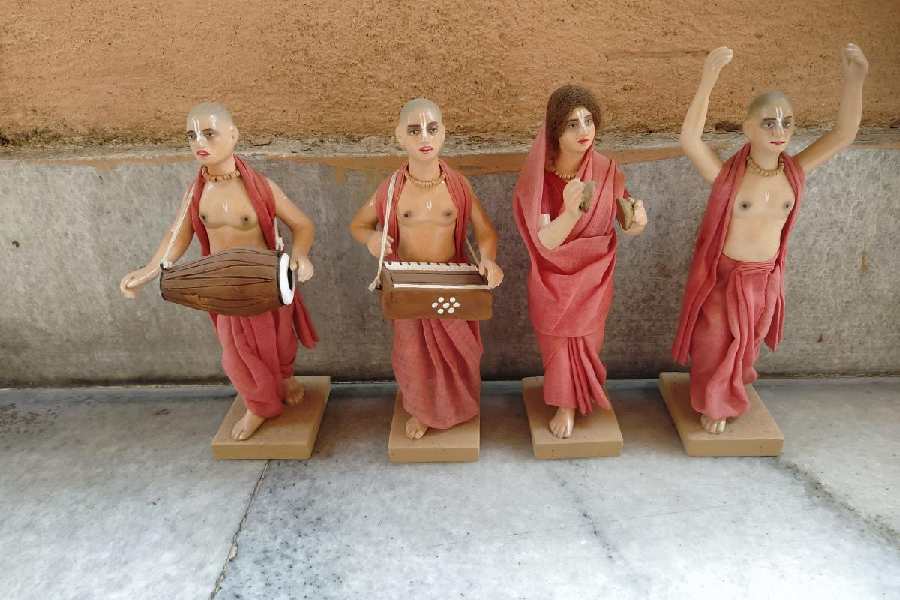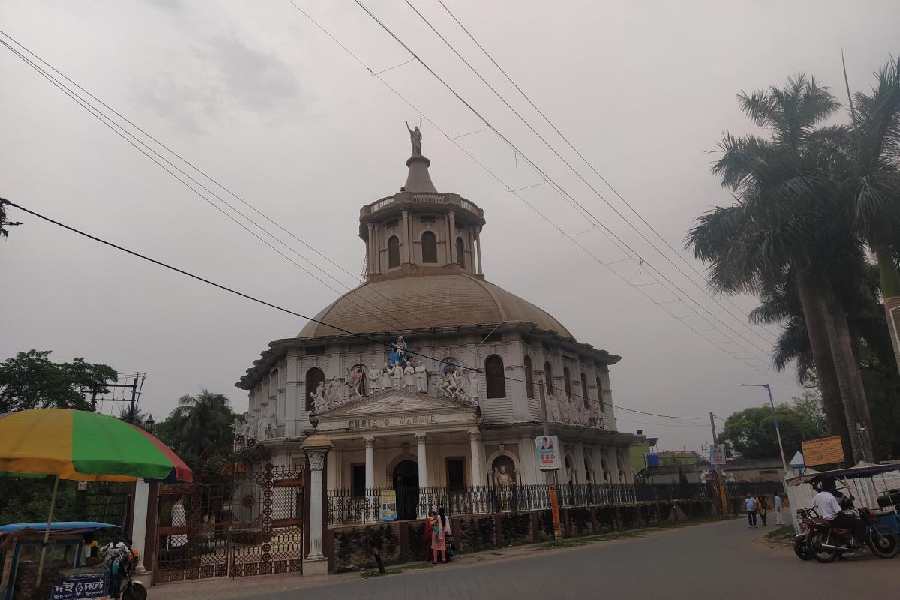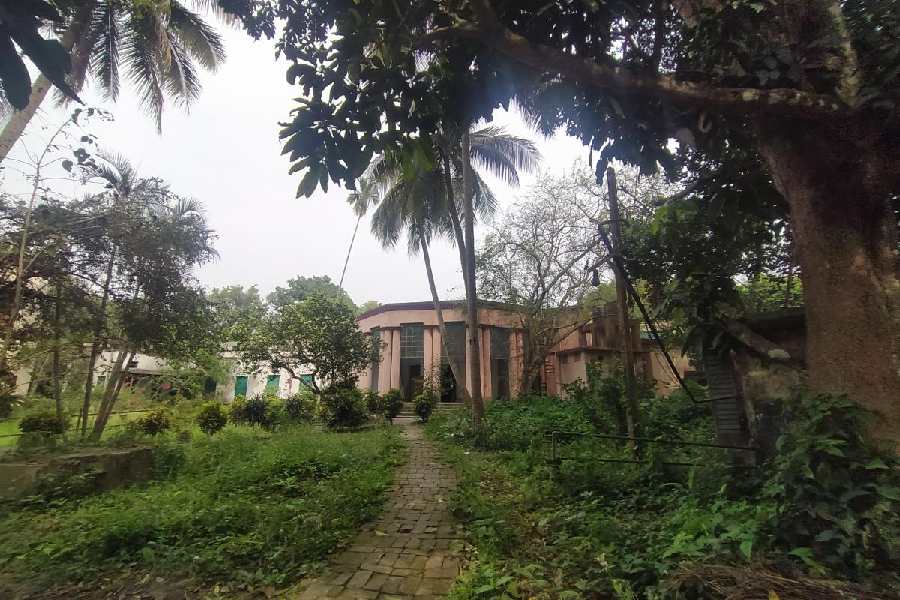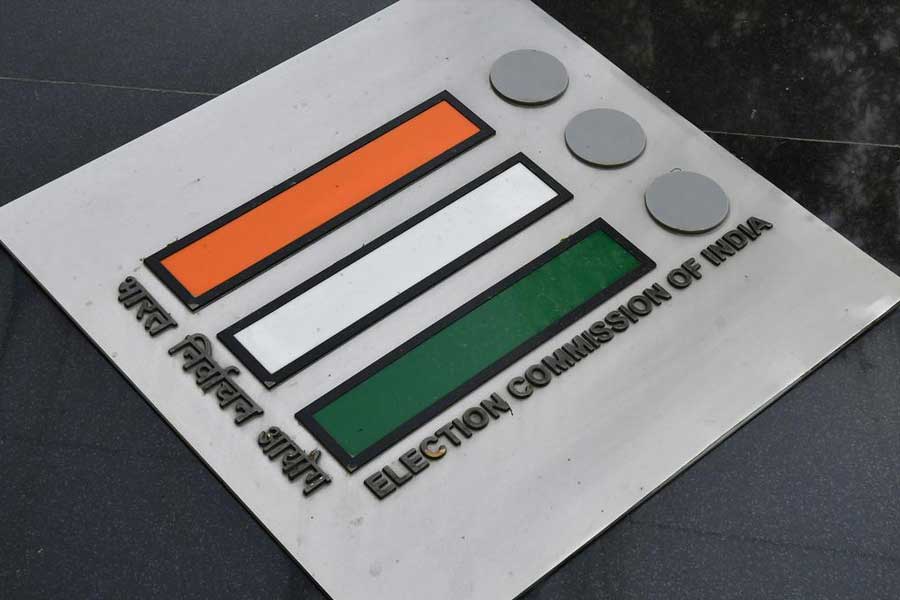One April morning, I arrived at the railhead of Krishnanagar City Junction. Sibnath Bhadra, a proud resident, and his two friends were supposed to show me around. All three are in their 70s, all members of Parampara, a local cultural organisation.
“Our city flourished as the intellectual and cultural capital of Bengal in the 15th century, much before Calcutta was born,” said Bhadra even as our minivan negotiated the crowded streets and alleys. “This is a hub of Vaishnavite literature and music. Also, it is our dialect that became Bengal’s formal accent, the standard colloquial Bengali,” he added.
The glory of Krishnanagar reached its pinnacle during the time of Krishnachandra Ray, who was zamindar of Nadia but was and continues to be referred to as “maharaja” or “raja”. He gives the town its name. But according to Devashis Mandal, former schoolteacher and one of my guides, the city does not take its name from him but the
deity Krishna.
It is said that Krishnachandra was part of the group that conspired against Bengal’s Nawab Siraj-ud-Daulah and colluded with Robert Clive for the foundation of British colonial rule in India. Not that that is Krishnachandra’s lone claim to fame. A patron of literature and culture, his court had eminent poets, scholars, artists, physicians, astrologers, musicians and dancers. Bharat Chandra Ray, said to be one of the greatest poets produced by Bengal, enjoyed the Raja’s patronage, as did the immortal jester Gopal Bhnaar, though some historians nitpick about the authenticity of this fact.

Rajbari thakurdalan, Krishnanagar
Our journey began with a visit to Krishnachandra’s palace, Bishnu Mahal. “Ranima just went out to campaign in the villages,” informed a man who seemed busy erecting a canopy right next to the palace gate for the upcoming festival of Barodoler Mela. Will people vote for her? He replied, “The city folks will, but she needs to convince those in the hinterland.”
We proceeded towards the thakurdalan — site of the famed Durga and Jagaddhatri pujas. It too wore a festive look. Mandal pointed to the intricate stucco work on the pillars, the clocks, iron chests, telephone sets, walking sticks, palanquins on display. On the walls beside them are giant oil paintings of Krishnachandra and his ancestors. The thakurdalan is open to visitors at the time of fairs and festivals.
Our next stop was Ghurni Putul Patty, a cluster of shops-cum-studios of famous clay sculptors, practising the craft for generations, producing classic Krishnanagar miniatures. A song came to mind, Geeta Dutt’s lilting voice — Krishnanagar theke ami Krishna khuje enechhi/Maatir putul, praaner putul, moner putul enechhi… In recent times, many of these craftsmen have shifted expertise to sculpting busts and statues of deities, political leaders and other celebrities.

Clay dolls, Ghurni, in Krishnanagar.
“Hardly 10 out of 100 artistes are doing well. This city is famous for its clay dolls across the world, but we hardly get any support from the government,” said a craftsman, who didn’t want to be named. “MPs or MLAs are not much bothered about our fate,” he added.
From Ghurni we travelled to Nediarpara, the mishti hub. The sarpurias and sarbhajas of this place are famous. These are made from a mix of chhana or cottage cheese, sor or cream of milk, almonds, pistachios and cardamom. Adhar Mistanna Bhandar draws a large number of buyers from the city and beyond.
Anupam Das, grandson of the shop’s founder, spoke about how sor is collected by boiling milk for hours on low flame in traditional earthen ovens. “This job is usually done by village women who supply us with the choicest variety of cream,” he informed. “Our karigars further refine the cream in our workshop and then turn it into sweets.” Das grumbled about the rising price of ingredients and the absence of government support for small enterprises like his.
Our minivan stuttered through congested lanes struggling for space with hundreds of totos, rickshaws and motorbikes. I spotted signs of unplanned urbanisation everywhere. My guides told me how hundreds of heritage structures have disappeared in the past three decades. One of the oldest municipalities of Bengal — established in 1864 — has failed to prevent the unbridled growth of apartment blocks and shopping complexes. Anjana rivulet that once served as the city’s central drainage was stolen by land grabbers years ago. I found parts of the lost river scattered across the city as blackened waterholes and garbage dumps.
The city’s decadence didn’t happen overnight. Once a hub of the freedom movement, in post-Independent India, the city chose the Congress and then the CPM as its Lok Sabha representative. In 1999, it elected advocate Satyabrata Mookherjee of the BJP, who went on to become a junior minister in the Vajpayee government. The next MP, the late Tapas Paul of Trinamool, got arrested in the Rose Valley chit fund scheme. For now, too much high-profile guardianship is choking Krishnanagar. There is Mahua Moitra, who became MP from Krishnanagar in 2019, but the city — made up of two Assembly constituencies Krishnanagar North and South — is under the guardianship of Trinamool’s Mukul Roy and Ujjal Biswas. “We expected a wind of change when the dynamic Mahua Madam took over. But except for many more apartment blocks and shopping malls, not much has changed,” said a shopkeeper near the railway station.
At dusk, we strolled along Don Bosco para, the town’s Little Europe with the magnificent Roman Catholic Church and Christo Mandir, which is a congregational hall. “The Catholic missionaries who arrived here in the early 19th century helped turn the city into a melting pot of cultures,” said Sampad Narayan Dhar, a heritage activist. The missionaries and local aristocrats founded dozens of educational institutes. The 178-year-old Krishnagar Government College is one such; for some reason developers and politicians alike have spared it thus far.

Christo Mandir, Krishnagar
After a dinner of maya maachher jhol and bhaat, early next morning we headed out to see the Jalangi river, adoringly called Khorey by the residents. There was a time when it was part of Bengal’s great river network. Large ships negotiated their way to East Bengal and Assam using this liquid path. But now, all that is there is a narrow nullah. I noticed several banners put up by citizen groups appealing to people to “Save Jalangi” from encroachers. “Mindless sand and clay mining has ruined the river,” explained Bhadra. The clay feeds hundreds of brick kilns by the river which in turn feed the city highrises.
In the mid-19th century, the city had also turned into a hotspot of indigo plantation. The loamy soil, courtesy Jalangi on the northern side, played a crucial role in the plentiful indigo harvest. “You can find the remains of some of the neel kuthis or indigo depots and homes of planters hidden inside government buildings,” said Bhadra.

Neel Kuthi in Krishnanagar. Now KGHSS school office.
He took me to see the remains of a kuthi inside Krishnagar Government Girls’ High School near the river. The headmistress Pratyusha De showed me around the remains of a planter’s office, stables, water pumps and a ballroom that now serves as an auditorium. “This was apparently the kuthi of one Feddie Sahib, notorious for torturing peasants who refused to grow indigo,” said De. She led us to a centuries-old
tamarind tree and added, “Years ago, rusted iron chains were found hanging from the branches. Legend has it that rebel peasants were hanged here.”
Those days are gone. Rebels and rulers have changed and so have their circumstances. As for Krishnanagar, the city and the constituency need a huge overhaul. Whoever wins in the election has a tough road ahead, tougher than merely how heated it can get.










